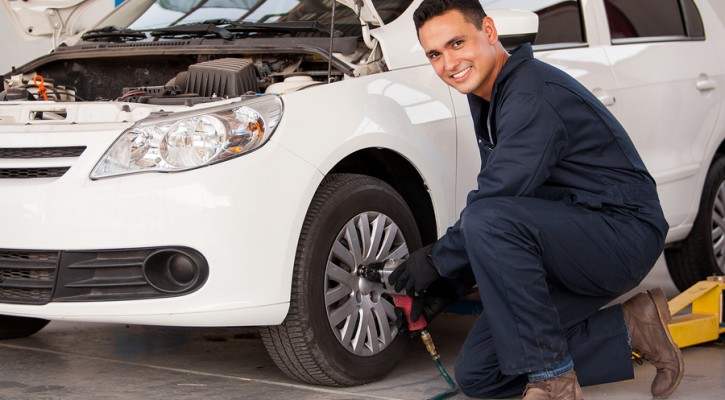
Tire Safety 101
June 2, 2014
It’s National Tire Safety Week all week long, so today we’re going to break down the basics of tire safety for your cars and trucks.
Tires keep us moving, help us stop, maintain traction and play one of the most important roles in keeping control over our vehicles. Without reliable, properly-inflated tires, cars and trucks can quickly turn into rolling death machines. And, even a slight drop in tire pressure can really drag our gas mileage down. So, it’s important to get in the habit of practicing proper tire safety.
1. Check tire pressure AT LEAST once a month.
Tires typically drop about 1 psi per month, and 1 psi for each 8-degree loss in ambient temperature. In many places across the U.S., temperatures can range far greater than 8-degrees in a single day. So, if your region is experiencing drastic temperature changes, it couldn’t hurt to check tire pressure weekly or even daily.
Uneven tire pressure immediately affects handling and control, as well as gas mileage. However, the long term effects can be even more concerning. Tire life decreases with poorly inflated tires because the tread wears out quicker on the outer edges, as well as increases stress on the tire as a whole through flexing and overheating.
2. Inspect tires AT LEAST once a month.
This is easy. Just do a quick walk-around, looking for excessive tread wear, cracks, bumps, chunking, punctures, or debris (such as screws & rocks). If you notice excessive tread wear, it could be a sign of steering or suspension misalignment.
If you notice tire damage, it is easy & cheap to take it in for repairs.
3. Maintain tires in proper balance.
Ever hear a thumping noise when driving down the highway? It could be an out-of-balance tire. This can cause uneven tread damage as well as an uncomfortable and embarrassing ride. If this occurs, have your tires dynamically balanced by an experienced technician right away.
Tires should always be balanced when first installed, and whenever remounted.
4. Rotate tires every 6,000 miles.
This is a general rule of thumb, though different vehicle manuals may specify different miles.
5. Maintain steering and suspension in proper alignment.
Many tire service shops offer a free alignment with the purchase of new tires. This is important because misalignment can cause rapid tire wear, as well as affect steering and stability of the vehicle. If you notice that your car pulls to one direction or the other, it may be time for an alignment.
6. Never overload your vehicle.
Overloading is the second leading cause of tire failure, just behind underinflation. Check the tire sidewall for maximum load range.
7. Don’t overheat tires.
Heat is another big tire killer. High speeds, high loads, underinflation, course pavement and aggressive driving all increase tire temperatures. This drastically decreases tread life and damages tire structure.
8. Install tires in matched pairs or complete sets.
When replacing tires, buy the same size, brand and type. If you can’t afford a complete set, then try to at least get a pair and install together as rear wheels. Even if the vehicle is FWD or AWD, putting new tires on the front and worn tires on the back will cause instability.
9. Buy the right tires for your vehicle and location.
All-season tires may work well in various locations, however, specialized tires will perform better for driving in rain, snow, ice, off-road and long distance conditions.
10. Replace tires BEFORE they blowout.
If tire tread is running low, it’s time for the old penny test. The Lincoln’s head on a penny can be substituted for a tire tread depth gauge as tires wear to the critical final stages. Place a penny into several tread grooves across the tire. If part of Lincoln’s head is always covered by the tread, you have more than 2/32″ of tread depth remaining. If Lincoln’s head is not covered, then a blowout is imminent.
Now that you know a thing or two about tires, practice the wisdom, spread the wisdom, and be a knowledgeable tire-safety advocate.
